Before you assume it: no, it is not about Captain Jack Sparrow and his team of VFX!
The middle of 17 century to the late 18 century is decisively known as the Golden Period in Piracy. Before it, many pirates erected the typical black flags in deep blue seas, yet they were washed ashore by new waves of buccaneers more powerful, crueler, and sabotaging.
These men led a free-spirited life, terrorizing not only the sea sailors but also the merchants of the coastal areas. Their stories, shrouded with adventurous legends of looting contraband, debauchery and drunken stupor amidst high tides precipitate them as an enigma. Some of the most notable ones are below.
So Ahoy mates! Climb aboard as we sail along the sea of the Golden Age of Piracy with ten of the most spectacular bands of desperados.
10. Bartholomew Roberts (Black Bart)
Content
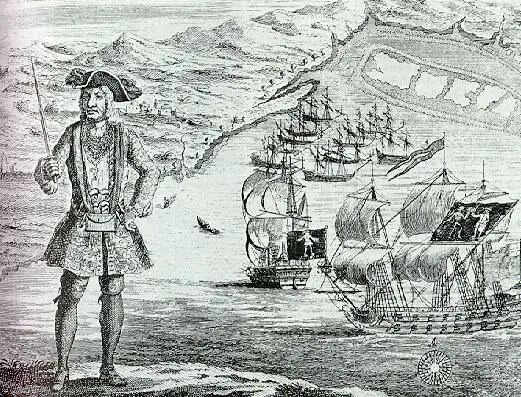
Source: Wikimedia Common
Bartholomew ‘Black Bart’ Roberts was perhaps one of the most victorious pirates in history. Throughout his career, he had plundered more than 400 ships.
He was born in Wales in 1682 under the name John Roberts. Therefore, it comes as a mystery as to why Bartholomew was his most famous name.
Roberts went to sea as a teenager but came into notice only in 1719 when he was a part of a sloop known as Barbados.
Roberts had become part of a slave ship known as the Princess, captained by Abraham, where he was the second mate and later became the captain.
His strength in the battles was so noteworthy that the crew would label him as bulletproof and immune to pistol fire.
In a year, he encountered 42 Portuguese ships, which were waiting for a military escort to get to Lisbon. Roberts and his men interceded.
He hijacked a ship known as Sagrada Familia, which contained 40,000 pieces of Portuguese gold and a haul of jewellery designated for the Portugal King.
The attack on the Portuguese fleet was a massive success. Perhaps, more of a success than most pirates saw in their lifetime.
Similarly, he burned many vessels and sold most of his loots before succumbing in a battle against the government of Britain. His death hammered the final nail in the coffin of the Golden Age of Piracy.
9. The Barbarossa Brothers
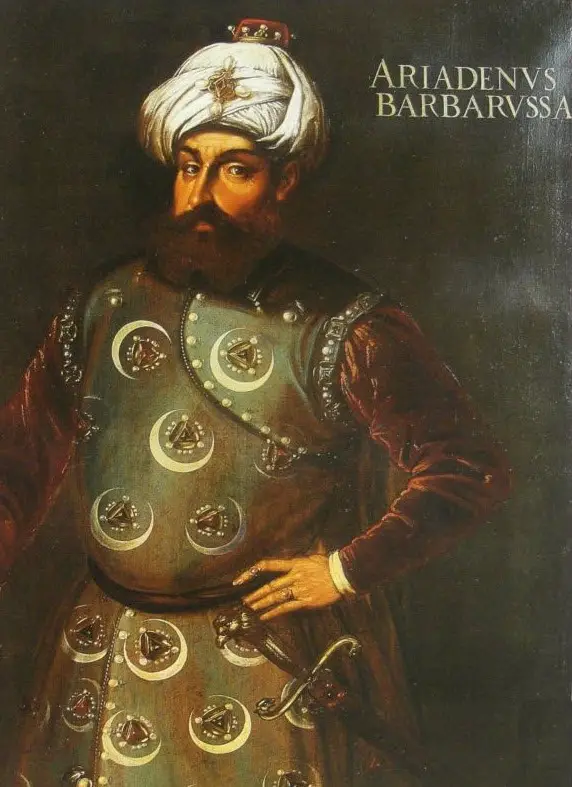
Source: Wikimedia Common
The Barbarossa Brothers, Oruc and Khizr, began their careers as sailors engaging in innocent marine affairs and international sea trade. Oruc, who was the second oldest brother, became a very successful seaman in his early career and would take his youngest brother under his wing.
During their rise to fame, they obtained the name Barbarossa, Italian for red beard, on the account that they had a red-beard.
By 1510, the brothers were the chief of more than half a dozen galleons. During this time, they also owned ample properties and had more than enough slaves to go around.
They went on to oppose Spanish intervention in many European settlements including Algeria, Andalusia, France, Valencia and many more. And by 1516, they had mastered a formidable presence, taking Algeria from Spanish control and nominated themselves as the new Sultans of the land.
Unfortunately, in 1518 the Spanish returned, posed a threat and Oruc lost his life in the battle. Khizr avenged his life and drove the Spanish away. He also freed about 70,000 Muslims from Spanish control.
Adorned as Grand Admiral of the Ottoman Navy, he was also given the name of Hayreddin by Suleiman, meaning the best of Islam.
Together, the Barbarossa Brothers changed the history of Europe.
8. L’Olonnais

Source: Wikimedia Common
Born in France in 1630, John-David Nau, better known as L’Olonnais, was perhaps one of the twisted and evil men as far as pirates go. How diabolical? How does ripping out the heart of someone and then taking a bite of its sound?
By 1650, he was an indentured slave in the Caribbean to an unidentifiable master. By 1660, however, he emancipated from the contract.
He would later wander the island before eventually ending up in what is now Haiti where his career as a Buccaneer began. He had a thing for preying on Spanish ships.
In his career, he became shipwrecked after an attack by the Spanish. Upon making it to the shore, the Spaniards had slaughtered his crew.
He only survived by covering himself in the blood in the blood of his allies and hiding amongst their corpses. Somehow he escaped and was able to defeat the entire crew sent after him beheading them all in a crazed bloody fury.
He arrived at Tortuga and in 1660, made his way to Maracaibo (modern-day Venezuela). He crossed paths with a Spanish treasure ship, captured it and looted the rich contents, namely: cocoa beans, gemstones and more than 260,000 Spanish dollars.
Lake Maracaibo hid an impregnable fortress with numerous guns. He intervened the territory in a few hours and was able to enslave everyone residing within, seizing their treasures. It was then that he earned quite a reputation for torturing the citizens who refused to obey him. Known as the bloodthirsty maniac, he was excessively cruel and vindictive.
He moved on to the eastern parts of the land, where the resistance of five hundred soldiers opposed him. He ferociously slew the soldiers before kidnapping the entire force and held it captive, demanding a pay-off.
He was nicknamed as the Bane of Spain after the word of his savagery reached Tortuga. Sadly, however, he died a tragic death.
His organs were amputated one by one and tossed into the fire. Similarly, his ashes were waved in the air to keep no vestige intact of such an infamous, inhumane creature. Yet here we are, reading about the most psychotic pirate.
7. Calico Jack
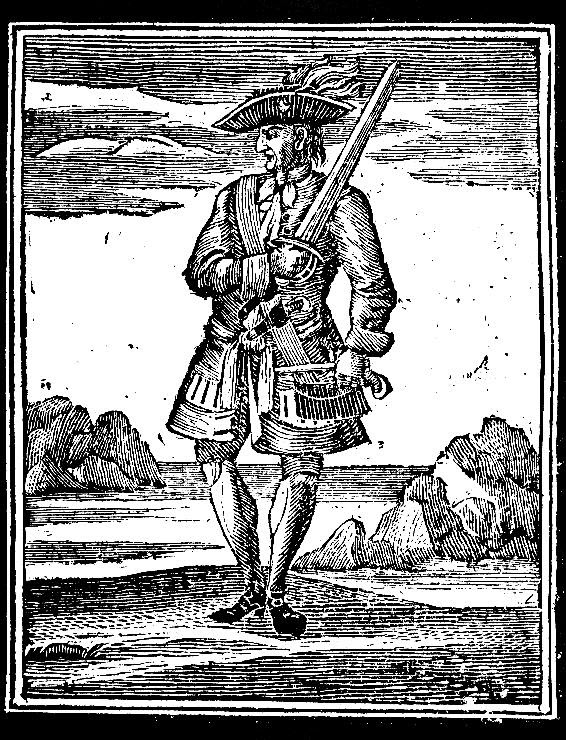
Source: Wikimedia Common
Calico Jack was neither a great fighter nor a good navigator. Still, he was a real pirate legend. Perhaps because Jack was the first pirate to create the flag that is now synonymous with all pirates: the skull with two of the swords crossing or maybe he was the only pirate who successfully incorporated women into his crew.
Born in 1682 in England as John Rackham, Calico was first historically mentioned in serving as a quartermaster on a pirate ship known as the Ranger. He received the name Calico Jack because of the bright Indian calico clothing he wore and Jack as the nickname for John.
As mentioned earlier, he wasn’t a fighter, nor was he particularly deft at sailing. His skills were that he was a conniving man of deception.
In 1718, the crew were en route home from a cumbersome pirate raid, where their supplies were low, while the ship was in dire need of repair. He outsmarted a captain to capture a Spanish treasure galleon right under from him.
The crew relegated Captain Vane under the incitement of Calico Jack, who assumed the position by outnumbering votes. Following his promotion as captain, they would plunder many small vessels off the coast of the West Indies and take captive a couple of large ships off Bermuda.
He met Anne Bonny and soon impregnated her. She leaves for Cuba to give birth where she meets another cross-dressing pirate, Mary Read. Together, all three steal a vessel from Nassau’s Harbor in August of 1720.
Much of their fate after the venture is unknown. Yet, Calico Jack is remembered for his bravery rather than pirating skills and his association with two ferocious female pirates in a male-dominated environment. Also, he might be the inspiration behind pop culture’s Captain Jack Sparrow.
6. Anne Bonny and Mary Read

Source: Wikimedia Common
A fiery redhead with a rebellious nature, Anne Bonny was an Irish pirate who operated in the Caribbean Sea in the 1700s.
Along with her reported temper, she would prove to be a versatile fighter on the decks and would earn her place as a renowned pirate despite living in a time where women were not equal to men.
Bonnie was born in the early 1700s and was a daughter to a prestigious lawyer, William Cormac. She resisted her marriage to run away with a sailor, James Bonnie, to the island of New Providence in the Bahamas, which was considered a haven.
There she became acquainted with Calico Jack and befriended Mary Read, another woman in Jack’s crew. Bonnie and Read would disguise themselves as men on board and perpetuate with ferocity and ruthless killings and looting.
Their camaraderie earned them infamous titles. However, they were unstoppable. They notoriously stole a new vessel called William and rebranded a crew. As they reached Jamaica, they preyed on low-risk ships to sustain them.
Anne Bonny and Mary Read would fight on decks like men. They were proficient in hand-to-hand combat, demonstrating articulate skills that saw them overcome their enemies.
5. Sir Henry Morgan
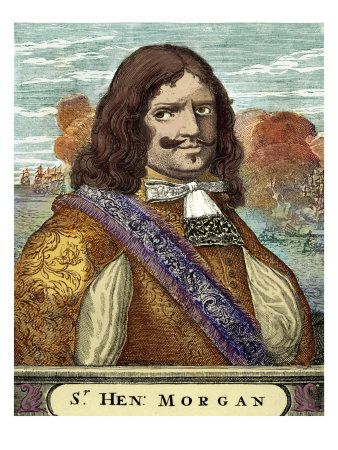
Source: Wikimedia Common
Sir Henry Morgan was a pirate and a plague to the Spanish in the 1600s. He was born a Welshman sometime in 1635 in Llanrumney. He registered in the Navy of England as a buccaneer at a young age.
In 1655, Jamaican island was under the rule of the buccaneers. He marched along with the English unit to loot the Caribbean Spanish colonies. He cultivated the skills of a dexterous sailor there until finally in 1662 he captained a vessel.
As the years unfolded, he successfully raided and plundered various ships around the Yucatan Peninsula and Granada in Central America. By and by, he amassed vast fortunes and soldiers.
He married the daughter of the governor-general of Jamaica. He also befriended the new governor, Sir Thomas Modyford, who heralded him as the vice-admiral.
Further, he led the Jamaican crew in 1668 to Cuba to curb the increasing Spanish attacks. There he suffered colossal damage of property and loss of crew members. He stood resilient in times of crises, bouncing back with brilliant tactics to invade the town of Puerto Rico. He stealthily approached the town from afar one night, murdered the guards and swiftly took over the land.
Similarly, he reigned terror in Venezuela next. In 1669, he conquered the land of Maracaibo with only a handful of ships and a few hundred shipmen. He mercilessly tortured and killed anybody who hid his treasures.
Every raid and fight he attempted, he accomplished with great dignity. So much that even the Spanish acclaimed his achievements. With such prolific conquest, he increased his crewmen and his property.
Perhaps the most significant battle in the life of Henry Morgan is his quest to conquer Portobello (modern-day Panama). A total of 1200 swashbucklers and 30 ships sailed towards the city. Yet another trick was conjured by Morgan, who after an upheaval against the fortified defence of Spaniards, plundered it entirely. It also happened to be the last raid of Morgan.
4. Edward Teach (Blackbeard)
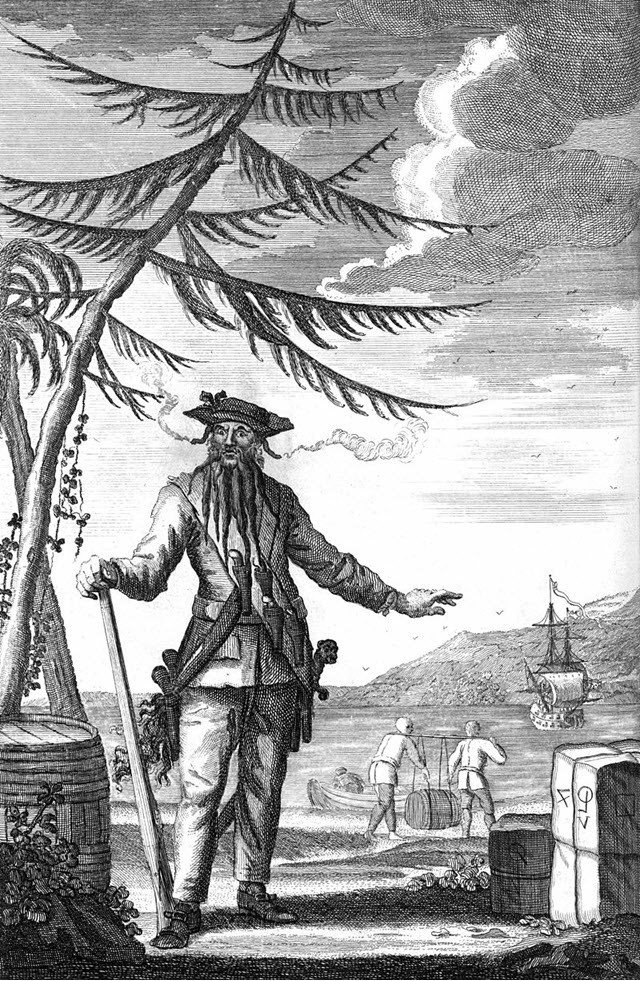
Source: Wikimedia Common
Bold, blunt and for the most part, untouchable. A story that Blackbeard lived his life as perhaps one of the most feared and formidable pirates ever existed.
However, much of his early life is shrouded in a fog of mystery. There is no official documentation of his real name, which leaves the scholars to a dilemma over his last name. He is also named Edward Thatch but best known as Blackbeard.
He was born in Bristol in around 1680 and sailed to the Caribbean while he was young. He served in Queen Anne’s war (1702-1713) along with other pirates until its conclusion. After the war, Teach moved to the Bahamas where he was a regular crewman. It was here that he met Captain Benjamin Hornigold, the man who would set the stage for the terrifying Blackbeard.
Together they plundered many ships including a powerful 300-ton French frigate known as the Concorde. Teach single-handedly upgraded the Concorde with 40 guns and renamed it as the Queen Anne’s Revenge.
A mane of facial hair decorated his countenance, which was uncommon at the time, giving him a distinct, peculiar, almost barbaric look. He understood that his appearance was vital in keeping terror intact. He sectioned his beard and tied it with colourful ribbons. He lit his beard and entered enemy ships with a smoky look that prompted them to surrender at once.
He went on to capture several vessels in the Caribbean, most notably, HMS Cobra, a powerful warship which heavily contributed to his reputation. In 1718 however, Blackbeard set to sail away from the Caribbean and wound up in North Carolina. He founded a new base of operations in the Ocracoke islands and preyed on passenger ships to plunder it.
The same year in May, he started the most daring plot in Charleston, South Carolina. Many of his crew members were sick and in dire need of medicine. Blackbeard and his crew were able to capture several ships, including the well known Crowley, which contained highly respected citizens on board. He laid siege to the town and threatened the governor to supply medications.
It was the pinnacle of his notoriety. Not only was he seemingly untouchable in the waves, but also he had accumulated a vast amount of riches in the land. He had become synonymous with pirating during that era his theatrics and strategic wit was so widely reported that he was making headlines on the print media outlets of the time.
3. Sir Francis Drake

Source: Wikimedia Common
Sir Francis Drake is considered a troublesome, villainous pirate by the Spanish. But to the English, he was a hero. Perhaps a morally flexible hero but a hero nonetheless.
Drake was born in 1540 and went to live on a ship of his family. Thus, beginning his fascination with sailing. At the prime age of 20, Drake would inherit his seniors trading ship through an apprenticeship, which facilitated the beginning of his naval expeditions.
He was favoured by Queen Elizabeth I who enlisted him as a privateer. It licensed him to plunder Spanish ships and ultimately earned him his revenge one attack at a time. He was known as El Draque, meaning the dragon in Spanish. He was loathed by the Spanish and was so devastating to their supply routes that their king, Philip II put a four million pound bounty on his life. Drake’s most celebrated venture was his capture of the silver train on March 15, 1573. Drake and his crew were able to obtain 20 tons of gold and silver but required to bury it for it was excess for their party.
After the peace treaty between England and Spain, he set sail along the coast of South America, continuing his vendetta against the Spanish and looting their vessels. It was until 1585 when he was redrafted by Queen Elizabeth to command a fleet of twenty-five ships when their bilateral relationships deteriorated.
In the following years, he had 30 ships to attack a Spanish fleet that was to join the Spanish Armada. Drake proved to be a menace once more and stormed a harbour known as Cadiz. He was able to destroy numerous wrestles and thousands of suppliers, which had a ripple effect in delaying Spanish Armada formation by a whole year. Drake was also the mayor of Plymouth. However, he is more revered for circumnavigating the world in a single attempt, captaining the ship called Golden Hinde.
2. Captain William Kidd
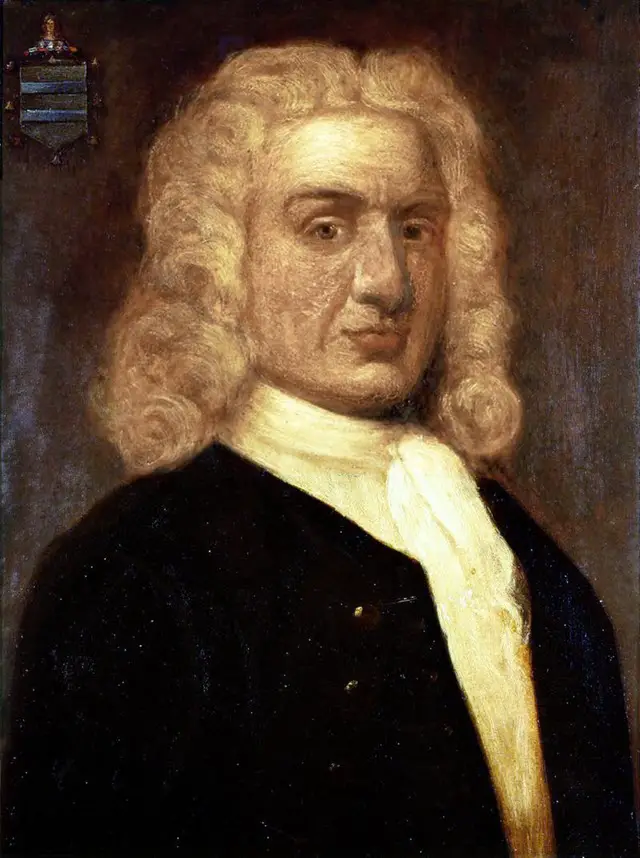
Source: Wikimedia Common
William Kidd was born in Scotland in 1654 but he moved to New York City to work as an apprentice aboard a pirate ship. It wasn’t until 1689 that Kidd became a part of a pirate crew in the Caribbean, where he asked the captain of the ship, Jean Fantin and organized a mutiny.
Kidd renamed the ship as Blessed William and was nominated as its captain. He raided many ships and collected much wealth. After he was recognized by the King of England, and summoned him in 1695. Soon, he befriended many elitists in England and was put in charge of the war-ship Adventure. Along with it came hundreds of crew members and fatal weapons such as cannons.
He was backed by the king himself to go on a spree evading French ships and pirates. These operations, although approved of and consigned by people of the law, were semi-legal. Hence, his adventures were not fateful and did not yield much except sustaining injuries.
However, in 1698, he laid siege to the ship belonging to the East India Company, Quedagh Merchant. Finally, he abandoned his precarious ship and boarded the newly captured vessel, renaming it as Adventure Prize. In turn, the defeated East India Company forcibly branded him as a pirate and was now a wanted fugitive.
In an attempt to flee to New York, he was arrested and extradited back to England and tragically in 1700, was executed for piracy.
1. Cheng I Sao
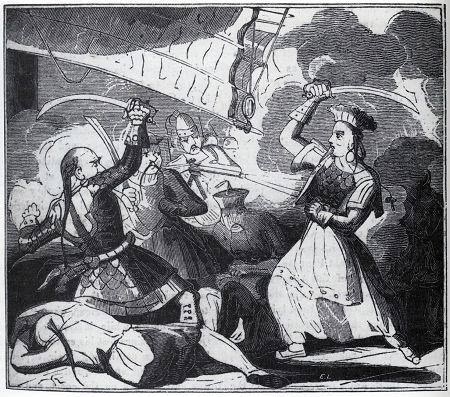
Source: Wikimedia Common
Ching Shih or Cheng I Sao or Madame Cheng, a Chinese pirate who terrorized the sea in the early 19th century, is remembered as perhaps one of the most devastating pirates to have walked the earth. Not only did she defeat the British, the Portuguese and the Spanish, but just about anybody else who crossed her.
One of the many reasons that make her story so compelling is that she was a woman who commanded 40,000 pirates in a time when they were considered second to their male counterparts. She was born into a very meagre means. There is very little information about her early life. Yet, we know that she was a prostitute working in a brothel in Guangzhou.
In 1801, she met Cheng I, a notorious pirate, who became infatuated by her and married her. From 1804 they were known as the Red Flag Fleet, commanding the Chinese waters. Even though her husband died, she wasted no time in mourning. Instead, she was scheming her way to maintain control over the fleet. She remained imperative amongst the crew members and captains.
Understanding that a lawless fleet would soon degenerate, she maintained a strict code in the ship. Firstly, she beheaded pirates if they disobeyed any orders from their superior. Secondly, no pirate was allowed to steal from the public fund, nor were they allowed to steal or harm any villages or their citizens.
Cheng had strict rules about the protection of female prisoners. Harming anybody even remotely entailed the death penalty. She released the uglier slaves while the beautiful ones were married off to the pirates.
She stirred conflict with many other countries boasting large naval ships. Any country wanting to instigate piracy in the Chinese sea would have to first battle with her. However, her power and reign started wearing off after 1810. By then, their organization had also disbanded. Eventually, she resorted to being a mistress again.
Conclusion
Pirates never penned official documents about themselves. Most intentionally so as to dodge legal consequences of their brutal actions. It is chiefly the reason why most of their early life is obliterated from history.
Nonetheless, it is derived from history that pirates did live an extravagant life, sailing off shores, exploring novel seaways and indulging in fascinating adventures. Each of them equally successful and famous, demonstrating unusual antics and indomitable power. All in all, they have helped to draw new contours on the global map through their expeditions.
